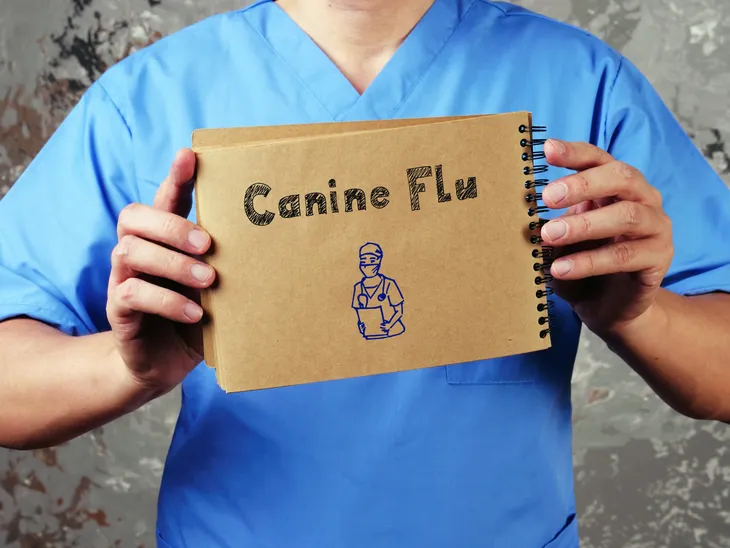- The canine influenza (dog flu) is a contagious respiratory disease caused by specific Type A influenza viruses known to infect dogs.
- The most common symptoms of canine influenza are cough, runny nose, lethargy, fever, eye discharge, difficulty breathing, and a reduced appetite.
- Any dog can contract canine influenza, but it’s more common in areas like kennels and shelters.
- Treatment for the dog flu is mostly supportive care. Keep them comfortable and well hydrated while their immune system works to fight off the virus.
We’re all familiar with the oh-so-dreaded flu season. Coughing, upset stomach, runny noses, and sneezing are just some of the miserable things we can expect during this time. That’s why so many medical professionals recommend people get the flu shot before flu season sets in. What people likely aren’t familiar with is the canine influenza, also known as the dog flu. That’s right! Our four-legged furry friends can also catch the flu.
Just like the human flu, canine influenza is a contagious respiratory disease caused by a virus that affects our dogs. Thankfully, it’s often not severe and most dogs will fully recover. But it’s still an unpleasant experience and there are a small percentage of animals that succumb to their illness. To keep our pets safe and healthy, learn more about the canine influenza virus, including the symptoms, causes, and treatment options…
What is Canine Influenza (Dog Flu)?
Just like the name states, the canine influenza is essentially the flu, but for dogs. It’s a contagious respiratory disease that is caused by specific Type A influenza viruses known to infect dogs, says the Centers for Disease Control and Prevention (CDC). These viruses are known as the “canine influenza viruses.”
There are two different influenza A dog flu viruses. “…one is a H3N8 virus and the other is an H3N2 virus. Canine influenza A (H3N2) viruses are different from seasonal influenza A (H3N2) viruses that spread annually in people,” explains the source.
Where Did it Come From?
The canine influenza H3N8 virus originated in horses. According to the CDC, the H3N8 equine influenza (horse flu) has been known to exist in horses for over 40 years. At some point it spread to dogs and is now more widely spread between dogs. It was first discovered in dogs back in 2004 when a group of greyhounds in the United States developed an unknown respiratory illness. After further investigation, it was found to be caused by the equine influenza A (H3N8) virus, explains the source.
“Scientists believe this virus jumped species (from horses to dogs) and has adapted to cause illness in dogs and spread among dogs, especially those housed in kennels and shelters,” writes the CDC. It’s now considered to be a dog-specific H3N8 virus.
The H3N2 virus originated in birds, says the CDC, and now spreads between dogs. There have also been reports of the H3N2 canine influenza in cats from infected dogs. This virus was first detected in dogs in South Korea in 2007 and has been reported in dogs in China, Thailand, and Canada. “H3N2 canine influenza viruses were first detected in the United States in April 2015, and has now been found in more than 30 states,” notes the source. The H3N2 virus in the United States is almost genetically identical (to date) to the one previously reported in Asia.
How is Canine Influenza Spread?
The canine influenza is just as easily transmitted as the human influenza and almost all dogs are susceptible. It’s more commonly spread through kennels and shelters due to their close proximity. It spreads through respiratory secretions, such as when dogs bark, cough, or sneeze, says VCA Canada, which can contaminate other dogs or land on surfaces like kennel walls, floors, food and water bowls, leashes, collars, and on the clothing of humans.
The source warns that canine influenza can survive on skin and hands for up to 12 hours and 24 hours for clothing. Other surfaces are even worse with a survival rate of up to 48 hours. If your dog is showing signs of respiratory disease, do not expose them to other animals and be sure to clean and disinfect all clothing, equipment, and wash your hands thoroughly.
Unlike the human flu, there is no “flu season” for canine influenza. Infections occur at the same rate all year round.
How Does it Infect Dogs?
Dog flu infects and replicates inside the cells lining a dog’s airways – from the nasal lining to the terminal airways, explains the AVMA. A dog’s body then provides an inflammatory response that often results in rhinitis, bronchitis, and tracheitis—all unique and serious types of infection.
This process leads to the death of the epithelial cells that run along the canine’s respiratory tract, leading to the exposure of membranes underneath. The result of these infections is typically nasal discharge (or runny nose) and coughing.
Signs and Symptoms of Canine Flu
The most common signs of canine influenza are a cough, runny nose, lethargy, fever, eye discharge, difficulty breathing, and a reduced appetite. However, some dogs will show no signs at all, says the CDC. The signs associated with dog flu will depend on the severity of their illness. Some dogs have no signs while others experience severe illness that can lead to pneumonia and sometimes even be fatal.
Symptoms of canine flu closely resemble kennel cough, another contagious illness. Contact a veterinarian if you suspect either of these illnesses.
What is the Incubation Period?
It takes about two to four days for an infected dog to start showing clinical signs, says VCA Canada. The dog will be most contagious during this short incubation period before the symptoms appear, making rapid transmission likely. The source also warns that they can spread the virus for up to 20 days after the fact.
For most dogs, the canine influenza is not serious. They typically fully recover within two to three weeks, says the CDC. “However, some dogs may develop secondary bacterial infections which may lead to more severe illnesses and pneumonia,” writes the source. If you’re concerned about your pet’s health or if they are showing signs of canine influenza, contact their veterinarian.
Can Humans Get Canine Influenza?
The CDC reassures that the canine influenza poses a very low threat to humans. There is no evidence that this virus spreads from dogs to people. To date, there has never been a known case of infection in a human since its emergence in 2004.
With that being said, influenza viruses are constantly changing. It is possible it could one day infect and spread between people. “Human infections with novel (new, non-human) influenza A viruses against which the human population has little immunity are concerning when they occur because of the potential that a pandemic could result,” warns the source. “For this reason, the World Health Organization global surveillance system has led to detection of human infections by novel influenza A viruses of animal-origin (such as avian or swine influenza A viruses).” To date, there have been no human infections with canine influenza A viruses.
Diagnosing Dog Flu
Canine influenza cannot be diagnosed solely based off clinical symptoms (i.e. coughing, sneezing, and nasal discharge) because they are all signs of many other canine respiratory illnesses. If dog flu is suspected, there are tests available for a proper diagnosis.
A veterinarian can accurately identify the canine influenza virus through virus isolation, immunoassays which detect virus antigen, PCR to detect virus nucleic acid, and serology for virus antibodies, says the American Veterinary Medical Association (AVMA). The most accurate and reliable test is the PCR.
Treating Canine Influenza
First and foremost, a veterinarian should be at the center of any canine influenza treatment regime. There are several steps to helping a dog overcome the flu and much of it is supportive care. Pet owners should keep their dog well hydrated and comfortable “while its body then mounts an immune response to the infection to facilitate recovery,” explains the CDC.
In mild cases of the canine influenza, medication from a veterinarian can help keep your dog more comfortable. Keeping your dog well hydrated is key. The source also notes that broad-spectrum antibiotics can be prescribed if a secondary bacterial infection is suspected.
Morbidity and Mortality Rate
The good news is that canine influenza is not widespread in the dog population. Most dogs will never come in contact with the virus. Unfortunately, for those who are, the morbidity rate (the number of exposed animals that develop the disease) is around 80-percent, according to the AVMA.
If your dog does happen to catch the dog flu, don’t worry. While it should be taken very seriously, the mortality rate is low. Less than 10-percent of dogs who get it succumb to this disease. It only happens in severe cases.
Preventing and Controlling Canine Influenza
The best way to prevent your dog from contracting canine influenza is to keep them away from other dogs. You should also try to avoid hot spots like kennels and shelters. If you come in contact with an infected dog or suspected infection, try to reduce the risk of transmission by washing your hands, arms, and clothing before touching your dog.
There are vaccinations available for both H3N8 and H3N2 strains of canine influenza. Ask your veterinarian for more information about getting your dog vaccinated against canine influenza.
Benefits and Risks of the Canine Influenza Vaccine
Thankfully, there are vaccines available to protect dogs against both H3N8 and H3N2 canine flu. Both are available in the United States, says the CDC. The decision to use any vaccine on a dog is based on their lifestyle and risk. Indoor dogs with little exposure to other dogs have a much lower risk than dogs in kennels or shelters.
People living in areas known to have canine influenza outbreaks should consider vaccinating their dog. Cases have been identified in some provinces in Canada, and across the United States. Older dogs with respiratory or heart disease, breeds with short, flat faces, are at a higher risk for infection and complications, warns VCA Canada.
It’s important to note, as with any vaccine, the canine influenza vaccine is not 100-percent effective in preventing the disease. However, it does reduce the severity and duration of the infection. It plays an important role in protecting at risk dogs and reducing the spread of outbreaks. Ask your veterinarian for more information about these vaccines and whether or not they are the right fit for your animal.















